Anywaves Antennas on the Hera Mission for Planetary Defence
The Hera mission, developed by the European Space Agency (ESA), represents a groundbreaking effort in planetary defense and asteroid science. Scheduled for launch in October 2024, Hera is part of the larger Asteroid Impact & Deflection Assessment (AIDA) collaboration with NASA. The mission aims to evaluate the kinetic impactor technique’s effectiveness, demonstrated by NASA’s Double Asteroid Redirection Test (DART) mission, in altering the trajectory of potentially hazardous asteroids.
Hera’s primary focus is on the binary asteroid system Didymos, specifically its moonlet Dimorphos, which was impacted by DART in September 2022. This mission is not only pivotal for validating asteroid deflection methods but also for advancing our understanding of asteroid characteristics and behavior.
A critical aspect of Hera’s success hinges on its communication systems and Anywaves is proud to be the provider of the S-Band Antennas for Hera’s CubeSats.
Let’s deep dive into the mission history and specifications, before taking a closer look to the timeline and upcoming milestones.
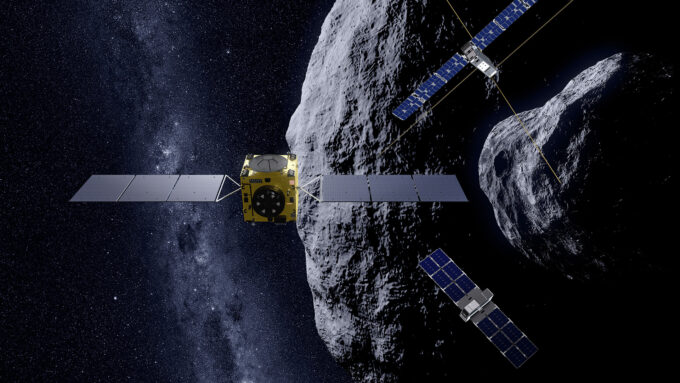
Credits: ESA/Science Office
Background and Context of the Hera Mission
Project History: AIDA and the Joint Effort with NASA
The Hera mission is part of the broader Asteroid Impact & Deflection Assessment (AIDA) project, the first operational program aimed at testing a method of deflecting near-Earth asteroids. Initiated in 2013, AIDA was a collaborative effort between scientists supported by NASA and ESA. The project’s objective is to test the use of an impactor-type device to alter the trajectory of an asteroid that could potentially collide with Earth.
AIDA planned to send two spacecraft to the binary asteroid (65803) Didymos: NASA’s DART (Double Asteroid Redirection Test) impactor, designed to crash at high speed into the smaller of the two asteroids, and ESA’s AIM (Asteroid Impact Monitoring) orbiter, intended to measure the impact’s effects. However, in late 2016, ESA decided to abandon AIM due to insufficient financial support from its member states. NASA continued with the DART project, incorporating the LICIACube nano-satellite to capture and transmit the first 100 seconds of the impact event.
Renaissance of the European Project
In 2017, prompted by several ESA member states, ESA revived the studies for a replacement of AIM, naming the new mission Hera, after the Greek goddess of marriage. Hera was designed to fulfill all the objectives initially assigned to AIM while optimizing the mission components. Hera’s primary goal is to study the effects of the DART impact on Dimorphos, the smaller moonlet of Didymos, four years after the collision.
The Hera mission was approved by the ESA Ministerial Council in November 2019. In September 2020, ESA awarded the construction of the spacecraft to a consortium of companies led by OHB.
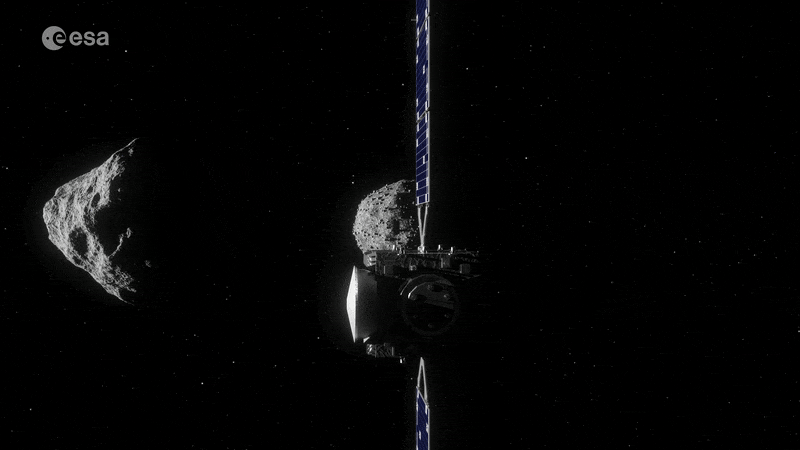
Hera approaching Didymos asteroids. Credit: ESA
The Hera Mission: Objectives and Importance
Primary Goal: Testing Planetary Defence
The main objective of the Hera mission is to evaluate the kinetic impactor method for deflecting a near-Earth object that threatens to crash into Earth. This deflection method involves modifying the trajectory of the asteroid by launching a spacecraft at a speed of a few kilometers per second. Of all the methods, this is the most mature because it relies on the use of available and cost-effective spacecraft technologies. To fulfill this objective, Hera must determine:
- How much momentum transfer depends on the density, porosity, and characteristics of the asteroid’s surface and internal structure.
- What proportion of the kinetic energy is transferred in the fragmentation and restructuring of the asteroid or in the kinetic energy of the ejected materials.
Secondary Goal: Understanding Asteroid Properties
Beyond planetary defense, the Hera Mission will also conduct detailed scientific investigations of Dimorphos. The spacecraft will examine the asteroid’s physical and compositional characteristics, including its mass, density, and structural integrity.
Hera will be the first mission to measure the subsurface and internal structures of an asteroid using the JuRA low-frequency radar on board the CubeSat Juventas. The entire moon, Dimorphos, will be mapped with a spatial resolution of a few meters and the vicinity of the impact with a resolution of 10 centimeters. The mass of Dimorphos will be estimated with high accuracy, allowing a direct estimate of the momentum transfer efficiency from the DART impact.
Technological Innovation: Paving the Way for Future Missions
Hera will also serve as a platform for testing new space exploration technologies. This includes the deployment of two CubeSats, Milani and Juventas, which will carry out specific tasks such as probing the asteroid’s interior and capturing high-resolution images of its surface. These endeavors will test novel instruments and operational techniques in the challenging environment of a small body’s low-gravity surface.
Moreover, the mission will explore advanced navigation and operational strategies for maneuvering around and interacting with asteroids. This is critical for the success of future missions that may require close-up interaction with asteroids, whether for scientific exploration, resource utilization, or planetary defense purposes.
Spacecraft Design and Payload
Hera Spacecraft
The Hera satellite is cubic, measuring 1.6 × 1.6 × 1.7 meters, and has a mass of approximately 1128 kg. Its energy is provided by solar panels with an area of 13 m². The spacecraft is stabilized on three axes, utilizing reaction wheels, gyroscopes, star trackers, solar sensors, and two Asteroid Framing Cameras (AFC). Attitude guidance is managed through the Planetary Altimeter (PALT).
CubeSats: Milani and Juventas
Milani CubeSat
Milani aims to take images and measure characteristics of dust and surface composition. It carries two primary instruments:
- The ASPECT hyperspectral imaging spectrometer, which operates in visible and near-infrared light (0.5 to 2.5 microns), with a spatial resolution of 2 meters at 10 kilometers and a spectral resolution of less than 40 nanometers.
- The VISTA thermogravimeter, responsible for detecting dust, volatiles, and light organic materials.
Juventas CubeSat
Juventas aims to determine the geophysical characteristics of Dimorphos. It carries the following instruments:
- The JuRa radar, operating at 50–70 MHz with a spatial resolution of 10 to 15 meters, is the first instrument to probe the inner layers of an asteroid.
- The GRASS gravimeter, with a dynamic range of 5 x 10⁻⁴ and a sensitivity of 5 x 10⁻⁷.
- A camera and a radio link with the mother ship, used to measure the Doppler effect and determine the characteristics of the gravitational field.
Both CubeSats are built around a similar platform, are 3-axis stabilized, and have a cold gas propulsion system. They communicate with the mothership in S-band and are equipped with accelerometers for surface property determination.
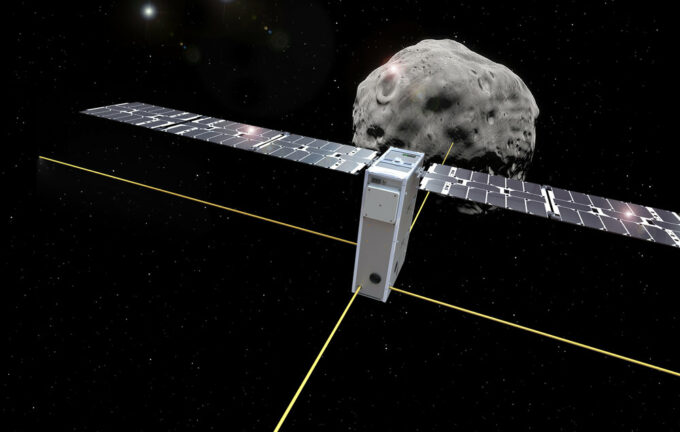
Juventas CubeSat. Credit: ESA
The S-Band Antenna Chosen: Anywaves’ Contribution
Anywaves is very proud to announce that our S-Band Antennas are a critical component of Hera’s cubesats communication system. Given the mission’s specific needs, Anywaves was tasked with creating antennas that could support reliable data transmission between the cubesats and the mothership.
Technical Specifications and Adaptations
To meet the specific needs of the mission, Anywaves provided 12 TT&C (Telemetry, Tracking, and Command) S-band antennas. These antennas operate at a shifted frequency of 2430 MHz, with a bandwidth of 40 MHz, optimizing the communication channel’s performance and reliability. This frequency shift and bandwidth allocation were critical adaptations to ensure the antennas could handle the data volume and provide timely and accurate information from the CubeSats to the Hera mothership.
Addressing Technical Challenges
The development and integration of these antennas involved addressing several technical challenges. First, the antennas needed to be highly reliable over the mission’s duration, capable of withstanding the harsh conditions of space, including extreme temperatures and radiation. Anywaves’ expertise in antenna design and space-grade manufacturing processes was crucial in meeting these requirements.
Furthermore, the antennas were designed to ensure compatibility with the spacecraft’s other systems and constraints, such as power consumption, size, and weight limitations. Anywaves was able to to customize the antennas’ design for these specific mission requirements.
Contribution to Mission Success
Anywaves’ S-band antennas are essential for maintaining the radio link between the Hera mothership and its CubeSats, Milani and Juventas. The Anywaves antennas enable the transmission of commands (such as position, velocity, and action commands) from the Hera mothership to the CubeSats. Additionally, they send back housekeeping status data and scientific payload data, including images and measurements, from the CubeSats.
The Hera mothership, in turn, is responsible for relaying all collected scientific data back to Earth.
The precision and reliability of Anywaves’ antennas directly contribute to the mission’s success, ensuring the seamless operation of the spacecraft and the achievement of the mission’s scientific and technical objectives.
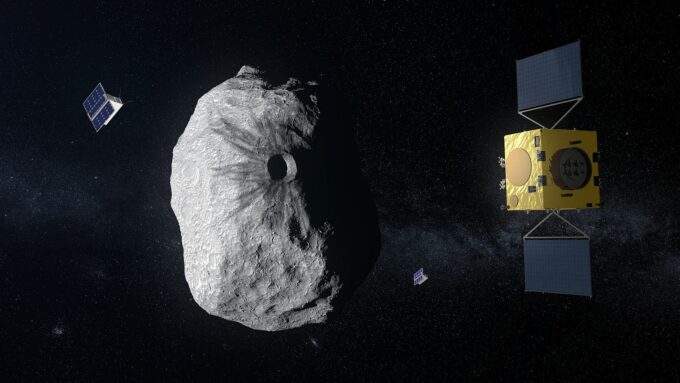
Credit: ESA
Mission Conduct and Timeline
DART Mission Overview
The American DART mission, launched on 24 November 2021 by a Falcon 9 rocket from Vandenberg Launch Station, reached the binary asteroid (65803) Didymos on 26 September 2022. It impacted Dimorphos at a relative speed of about 6.6 km/s. The impact was expected to change the orbital period of Dimorphos around Didymos by at least 73 seconds, a change observable by terrestrial telescopes.
Hera Mission Timeline
Hera is planned to be launched in October 2024 by a Falcon 9 rocket from Cape Canaveral. Shortly after launch, a deep-space maneuver will be conducted by November. Following a gravitational assist at Mars in March 2025, where Hera will observe the Martian moon Deimos, the spacecraft will reach Didymos on 28 December 2026. Hera will then begin a six-month investigation of the binary asteroid system, marking the first rendezvous with a binary asteroid. The mission will proceed through five stages:
- Early characterization phase
- Deployment phase of the two nano-satellites
- Detailed characterization phase
- Close observation phase
- Landing of both Milani and Juventas on Dimorphos, with a potential final experiment involving a landing on Didymos by the main spacecraft
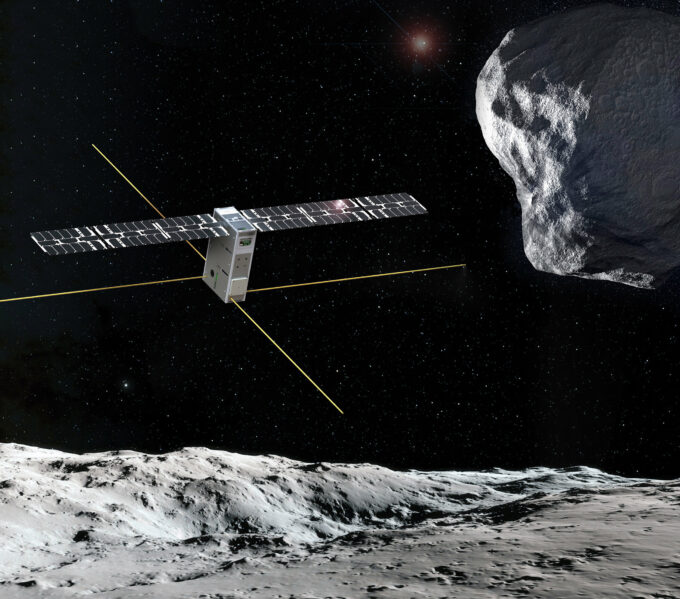
Juventas landing on Dimorphos. Credit: ESA
Conclusion
The Hera mission is an important step forward in planetary defense and asteroid science. By testing the kinetic impactor technique, the mission aims to find an effective way to deflect potentially dangerous asteroids. Hera will closely study the binary asteroid system Didymos, focusing on its moonlet Dimorphos, to understand the impact of NASA’s DART mission.
A key part of Hera’s success is its communication system, supported by Anywaves’ S-band antennas. These antennas enable reliable communication between the Hera mothership and its CubeSats, Milani and Juventas, facilitating the transmission of commands and the reception of housekeeping status and scientific data.
Hera is scheduled to launch in October 2024, with a detailed plan to study the asteroid system over several phases. The collaboration between ESA, NASA, and Anywaves highlights the importance of teamwork in advancing space exploration and planetary defense. The knowledge gained from the Hera mission will contribute to future missions and improve our ability to protect Earth from asteroid threats.
Contact
us
If you have any question, we would be happy to help you out.


